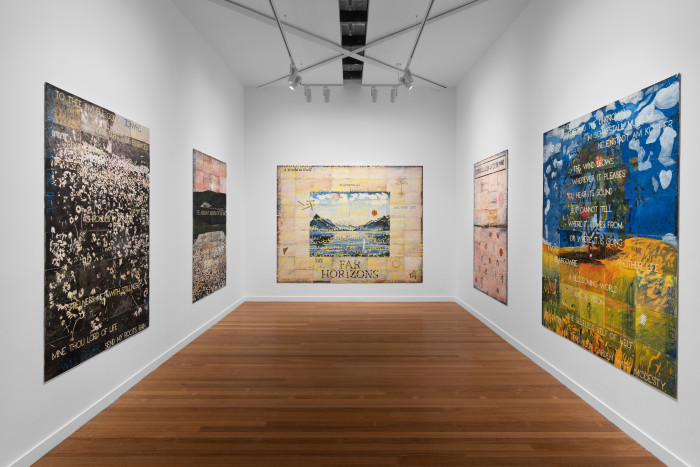The multiple canvasboards that make up each painting in this exhibition are also pages within Imants Tillers’ ongoing painting project, named the “Book of Power”. Because of Tillers’ quotational methodology, however, it is not just his thoughts that fill this room and the metaphorical Book that lines its walls, but those of his source artists. Tillers’ Book is defined by a connective impulse that, though it relies on disparate material to form its contents, orchestrates convergences between both images and words across many eras, places and cultures.
Even in the seven paintings displayed here, tens of sources might be identified, and thus, tens of histories. For example, Tillers painted Ferdinand Hodler’s walnut tree to refer to a walnut’s presence within his own garden, yet what did the Swiss artist think about that special being he depicted over a century ago, with such care and intimate knowledge? Elsewhere, whose hands was Austrian artist Egon Schiele painting, in their dance of to-touch or not-to-touch; what did they think about each other, and how did they relate? Perhaps, as Tillers has glossed them, each hand gave presence to the other – “In thy sight we bloom”. And what might Norwegian painter Harald Sohlberg have thought about, wandering through flower meadows so distant from now, but still resonant, Tillers finds, to the highland grasslands surrounding his home?
These works are but a glimpse into the Book’s whole, which grows continuously, board by board, or page by page. If Tillers’ whole Book were conceived as a room filled with thoughts, how might it appear? And if this room in which we now stand is but its antechamber, how much further might we have to see, and who might we meet, around that corner where voices – hundreds of them – swell and lilt in endless conversation?
– Clare Fuery-Jones, 2025
–––––
In 1981, I started making paintings which constituted of assemblings of canvasboard units (originally 10” x 15”) but now typically 10” x 14” making up a greater whole. I numbered each canvasboard unit, beginning with the number one and now after 44 years, I am up to 117,353. While most of these paintings have a mosaic-like structure, they vary greatly in terms of subject-matter, imagery and technique. Often, however, I have made works as part of a series, set or sequence. Also, from time to time, I have exhibited many disparate paintings stacked together and called them a new work. Indeed, in my studio, the works are usually presented in this stacked form and not as images on the wall. This serves to remind me that all my paintings and, in fact, all the canvasboard units of which they are composed, are part of one, ever-expanding ‘whole’ which I once referred to as “The Book of Power”. However this ‘whole’ seems to have an elusive autonomy which makes it difficult to define or event to name. What is it?
Some time ago (in fact in 1998), it occurred to me that an illuminating way to look at this body of work is to see it in terms of a series of levels of organisation arranged in a kind of nested hierarchy. At each level, things are both ‘whole’ and ‘parts’.
At the lowest level, we have the fundamental unit which is generally a canvasboard panel. My favourite brand is ‘Frederix’, “serving artists since 1868” – (including the French Impressionists and the early Papunya Tula artists!).
Thee second level is the level of the composite painting on the wall. To date, these have consisted of 1 to approximately 300 canvasboards each. But there is not limit to their possible size.
The third level is the level of sets, sequences, series or exhibitions which may be explanations of particular sub-themes, sources, techniques or questions.
The last level is the level of the complex whole – what I once called, ‘The Book of Power’ which is constantly growing, forming, transforming. The Unnameable.
At each level things are both wholes and parts just as in nature. Atoms are wholes consisting of sub-atomic parts, crystals are whole made up of molecular parts – likewise cells within tissues, tissues within organs, organs within organisms, organisms within societies, societies within ecosystems, ecosystems within Gaia, Gaia in the solar system, the solar system in the Galaxy and so forth- everywhere levels within levels of organisation, each system at the same time both a whole made up of parts and a part within a larger whole.
So how to talk about the work presented here? A Room Filled With Thoughts: the Beginliness of the Beginning.
Everything begins with Thought. But what is thought?
Paintings are thoughts made manifest. Thoughts made concrete out of matter – in my case, paint on canvasboards – pigment on canvas stretched over cardboard. Equally thought can become manifest as writing or composing of music on sheets of paper. But do we really know what thought is and where it comes from? Heidegger once suggested: “thinking is thanking”. The Rosicrucians once declared: “THOUGHTS HAVE WINGS”. I describe the way and meanwhile I am proceeding along it.
– Imants Tillers, ‘Blairgowrie’, 11 July 2025.
View exhibition
